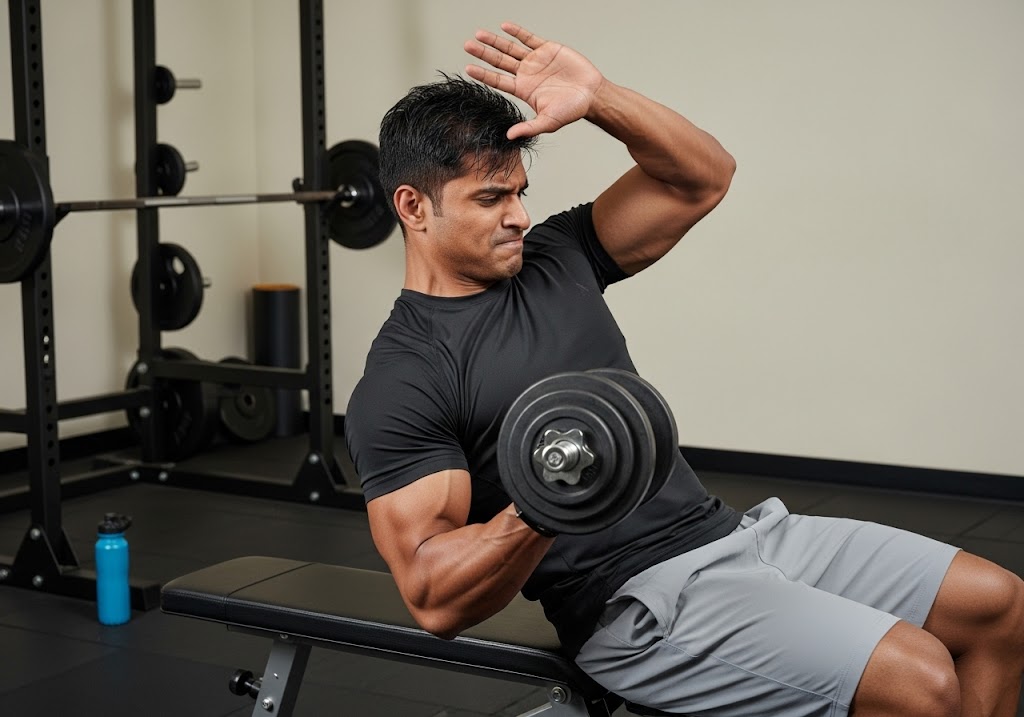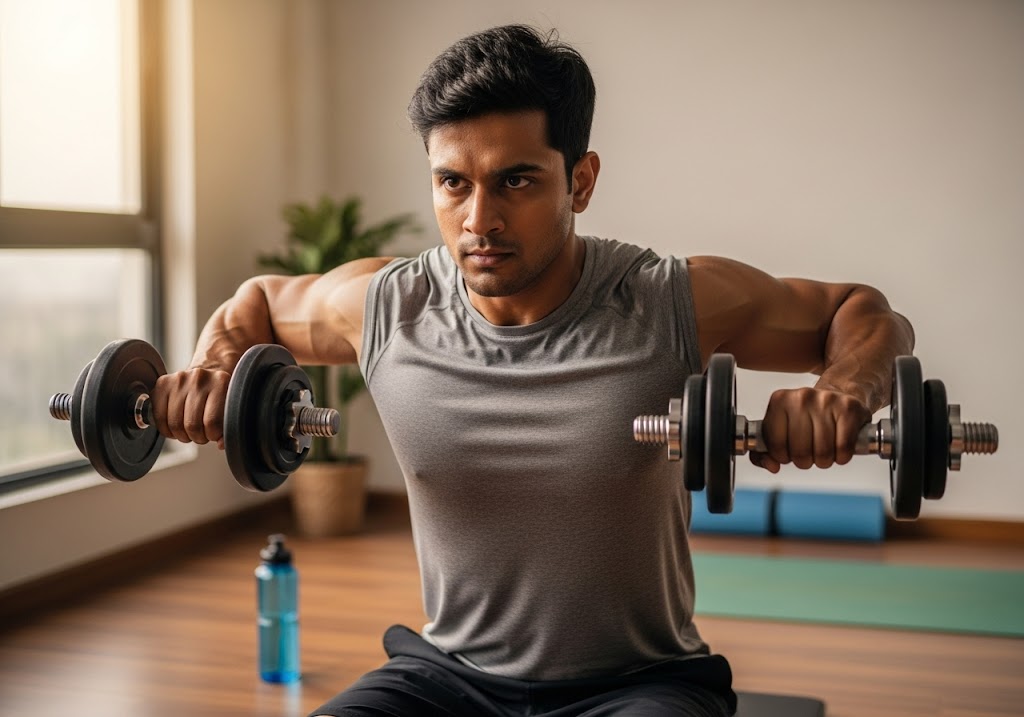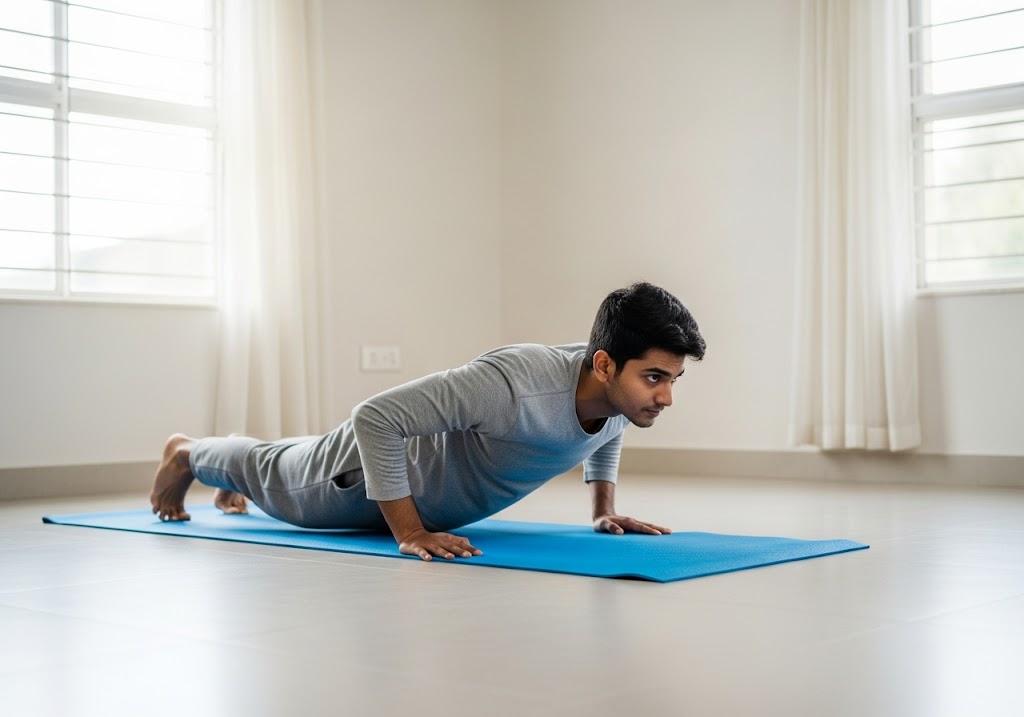The Arnold press involves rotating dumbbells from a palms-facing position to overhead pressing while seated or standing, targeting all three shoulder heads effectively.
The Arnold press stands as one of the most effective shoulder exercises for building complete deltoid development. Named after Arnold Schwarzenegger, this movement combines rotation with pressing to target all three heads of the shoulder muscles. Learning how to do Arnold press properly can transform your shoulder training and create the wide, powerful shoulder appearance that made Arnold famous.
This exercise differs from regular shoulder presses by incorporating a rotation element that activates more muscle fibers. When you master how to do Arnold press, you engage the front, middle, and rear deltoids simultaneously. The unique movement pattern also works your rotator cuffs and stabilizing muscles more than traditional pressing movements. Whether you’re a beginner or experienced lifter, understanding how to do Arnold press correctly is essential for maximizing results while preventing injury. This movement requires proper form, controlled tempo, and appropriate weight selection to be effective and safe.
Table of Contents
How to Do Arnold Press?
Understanding how to do Arnold press starts with recognizing its unique characteristics and movement pattern. This exercise combines the benefits of front raises, lateral raises, and overhead pressing into one fluid movement, making it incredibly efficient for shoulder development.
| Exercise Component | Description | Benefit |
|---|---|---|
| Starting Position | Palms facing body, elbows close | Targets front deltoids |
| Rotation Phase | Rotate palms outward while lifting | Engages middle deltoids |
| Press Phase | Press weights overhead | Works all deltoid heads |
| Lowering Phase | Reverse the movement slowly | Controls eccentric strength |
| Full Range | Complete rotation and press | Maximizes muscle activation |
The Arnold press works differently from standard shoulder exercises because of its rotating component. When you learn how to do Arnold press, you’re essentially performing multiple exercises in one movement. This makes it highly time-efficient while providing superior muscle activation compared to isolated shoulder movements. The exercise can be performed seated or standing, though most people find the seated version easier to control when starting out. The key to mastering how to do Arnold press lies in smooth coordination between the rotation and pressing phases of the movement.
Building foundational strength with calisthenics at home no equipment exercises can improve your pressing performance.
Step-by-Step Instructions:
- Step 1: Choose your preferred position – seated with back support or standing
- Step 2: Hold dumbbells with appropriate weight for 8-12 controlled repetitions
- Step 3: Position weights at shoulder height with palms facing your torso
- Step 4: Keep elbows slightly forward, not flared completely to the sides
- Step 5: Initiate the movement by pressing upward while rotating wrists
- Step 6: Maintain tension in your shoulders throughout the entire range
- Step 7: Rotate palms outward as you reach the halfway point
- Step 8: Complete the press with arms extended and palms facing forward
- Step 9: Hold the top position for a one-second pause
- Step 10: Begin lowering while simultaneously rotating palms back inward
- Step 11: Control the negative portion to maximize muscle activation
- Step 12: Return to starting position with palms facing your body
- Step 13: Avoid bouncing or using momentum between repetitions
- Step 14: Focus on smooth, deliberate movement patterns throughout
If you experience shoulder discomfort during pressing movements, discover which exercise is best for back pain as proper posterior chain strength supports healthy shoulder function.

What is Arnold Press?
The Arnold press represents a modified shoulder pressing movement that incorporates rotation to maximize deltoid activation. This exercise was popularized by Arnold Schwarzenegger during his competitive bodybuilding career. Understanding what makes the Arnold press unique helps you appreciate why learning how to do Arnold press is so valuable.
Unlike traditional shoulder presses that move in a straight line, the Arnold press begins with your palms facing your body. As you press the weights up, you simultaneously rotate your wrists so your palms face forward at the top. This rotation engages muscle fibers that standard pressing movements often miss.
The exercise effectively combines three different shoulder movements into one fluid motion. You get the benefits of front raises during the initial lift, lateral raises during the rotation phase, and overhead pressing at the top. This comprehensive movement pattern is why mastering how to do Arnold press can accelerate your shoulder development significantly.
For optimal results, combine your Arnold press training with proper nutrition guidance from our intermittent fasting plan.

How to Do Arnold Press?: Step-by-Step Instructions
Mastering the step-by-step process for how to do Arnold press requires careful attention to each phase of the movement. Breaking down the exercise into distinct steps helps ensure proper form while building muscle memory for this complex shoulder exercise.
Step 1: Setup and Starting Position
Proper setup forms the foundation for learning how to do Arnold press effectively. Your starting position determines the success of the entire movement, so take time to establish correct posture and dumbbell positioning before beginning any repetitions.
Sit on a bench with back support or stand with feet shoulder-width apart. Hold a dumbbell in each hand at shoulder level with your palms facing your body. Your elbows should be close to your sides, and the weights should be positioned near your chest. Engage your core muscles to maintain stable posture throughout the movement.
For comprehensive core strengthening, explore our calisthenics ab workout routines.
Step 2: The Rotation and Lift Phase
The rotation phase separates how to do Arnold press from standard shoulder exercises. This component requires smooth coordination and controlled movement to maximize effectiveness while maintaining proper form throughout the range of motion.
Begin lifting the dumbbells while simultaneously rotating your wrists outward. As the weights rise, your palms should gradually turn from facing your body to facing forward. Keep your core engaged and avoid arching your back excessively during this phase.
Step 3: The Overhead Press
The pressing phase completes the Arnold press movement pattern. Once your palms face forward and the weights are at shoulder level, continue pressing the dumbbells straight up overhead until your arms are fully extended but not locked out.
Press the weights up in a controlled manner, focusing on squeezing your shoulder muscles at the top. Avoid banging the dumbbells together overhead, as this can disrupt your balance and reduce muscle tension.
Step 4: The Controlled Descent
The lowering phase of how to do Arnold press provides significant muscle-building benefits when performed correctly. This eccentric portion should be slower and more controlled than the lifting phase to maximize muscle tension and growth stimulus.
Slowly lower the weights while reversing the rotation. As you bring the dumbbells down, rotate your palms back to face your body. Control the descent until you return to the starting position with the weights at chest level.

Benefits of Arnold Press Exercise
Understanding the specific benefits of learning how to do Arnold press helps justify its inclusion in your shoulder training routine. This exercise provides unique advantages that traditional shoulder movements cannot match, making it valuable for complete deltoid development and functional strength.
The Arnold press provides comprehensive deltoid activation through its rotating movement pattern:
- Complete Deltoid Activation – When you perform how to do Arnold press correctly, you work the front, middle, and rear deltoids more completely than isolated exercises, leading to better overall shoulder development
- Enhanced Shoulder Stability – The rotation component challenges your rotator cuff muscles and smaller stabilizing muscles more than fixed-path pressing movements, improving joint stability
- Improved Coordination – Learning how to do Arnold press develops better neuromuscular coordination between multiple muscle groups working simultaneously
- Time-Efficient Training – Combines multiple movements into one exercise, allowing you to train front raises, lateral raises, and overhead presses simultaneously
- Better Muscle Balance – The rotating movement helps prevent muscle imbalances that can develop from only performing straight-line pressing movements
- Increased Range of Motion – Provides greater shoulder mobility and flexibility compared to standard pressing exercises
- Functional Strength Transfer – The complex movement pattern improves real-world strength applications and daily activity performance
How to Do a Standing Arnold Press?
The standing Arnold press is a dynamic shoulder exercise that combines rotation with overhead pressing, targeting all three deltoid heads while engaging your core for stability. Named after Arnold Schwarzenegger, this compound movement builds impressive shoulder mass and strength through its unique rotating motion that maximizes muscle activation throughout the entire range of motion.
Step-by-Step Instructions:
- Step 1: Stand with feet shoulder-width apart, holding dumbbells at shoulder height
- Step 2: Position dumbbells with palms facing your body (pronated grip)
- Step 3: Keep your core engaged and maintain a neutral spine throughout
- Step 4: Begin rotating your wrists outward while simultaneously pressing upward
- Step 5: Continue the rotation until palms face forward at the top position
- Step 6: Press dumbbells fully overhead until arms are extended
- Step 7: Pause briefly at the top with arms locked out
- Step 8: Reverse the motion by lowering while rotating palms back toward you
- Step 9: Return to starting position with palms facing your body
- Step 10: Maintain control throughout the entire movement pattern
For building a strong foundation that supports overhead pressing movements, learn how to do glute bridge exercises to develop proper hip stability and core strength.
How to Do an Arnold Dumbbell Press?
The Arnold dumbbell press revolutionizes traditional shoulder training by incorporating a twisting motion that engages more muscle fibers than standard presses. This exercise targets the anterior, medial, and posterior deltoids while improving shoulder mobility and stability. The unique rotation pattern creates continuous tension throughout the movement, making it superior for building both strength and size.
Step-by-Step Instructions:
- Step 1: Sit on a bench with back support, holding dumbbells at chest level
- Step 2: Start with palms facing toward your body, elbows bent at 90 degrees
- Step 3: Keep your feet planted firmly on the floor for stability
- Step 4: Engage your core to maintain proper spinal alignment
- Step 5: Begin the upward movement while simultaneously rotating your wrists
- Step 6: Turn palms outward as you press the weights overhead
- Step 7: Continue pressing until arms are fully extended above your head
- Step 8: Pause at the top position with palms facing forward
- Step 9: Slowly reverse the movement, rotating palms back inward
- Step 10: Lower dumbbells back to starting position at chest level
- Step 11: Maintain smooth, controlled motion throughout each repetition
- Step 12: Focus on feeling the rotation and stretch in your shoulders
Understanding the differences between training methods can help optimize your shoulder development – explore calisthenics body vs gym body to see how various approaches affect muscle development.
Muscles Worked in Arnold Press
The Arnold press targets multiple muscle groups simultaneously through its unique movement pattern. Understanding which muscles work during how to do Arnold press helps you optimize your training and ensure balanced development across all targeted areas.
| Muscle Group | Primary Role | Activation Level |
|---|---|---|
| Anterior Deltoids | Front shoulder pressing | High |
| Medial Deltoids | Side shoulder lifting | High |
| Posterior Deltoids | Shoulder stability | Medium |
| Triceps | Arm extension | Medium |
| Rotator Cuffs | Shoulder rotation | Medium |
| Core Muscles | Stability and posture | Low-Medium |
The primary muscles worked are the three heads of the deltoids. The anterior (front) deltoids work heavily during the initial lifting phase. The medial (middle) deltoids activate strongly during the rotation phase. The posterior (rear) deltoids help stabilize the movement throughout.
Secondary muscles include the triceps, which help extend your arms during the pressing phase. Your rotator cuff muscles work to control the rotation, while your core muscles maintain posture and stability throughout the movement.
For complete shoulder development comparisons, check out our analysis of arnold press vs shoulder press techniques.

Arnold Press Variations
Exploring different variations of how to do Arnold press allows you to target muscles from various angles while accommodating different fitness levels and preferences. These modifications help prevent training plateaus while providing options for progression and customization based on individual needs.
Seated Arnold Press
The seated variation provides better stability for beginners learning how to do Arnold press. Using a bench with back support helps maintain proper posture and reduces the risk of using momentum or excessive back arch during the movement.
Sit with your back firmly against the bench pad, feet flat on the floor. This position allows you to focus entirely on the shoulder movement without worrying about balance or core stability issues.
Standing Arnold Press
Standing Arnold press challenges your core stability more than the seated version. This variation requires greater balance and coordination, making it more functional for everyday activities and sports performance applications.
Stand with feet shoulder-width apart, core engaged, and maintain neutral spine alignment throughout the movement. Avoid leaning back or using leg drive to assist the pressing motion.
Learn more about proper training principles with our how to lift heavier weights techniques.
Single Arm Arnold Press
Performing how to do Arnold press with one arm at a time increases the stability challenge and helps identify strength imbalances between sides. This variation also allows you to focus on perfect form for each arm individually.
Hold one dumbbell while keeping the opposite hand available for balance if needed. Maintain level shoulders throughout the movement and avoid rotating your torso to assist the pressing motion.
Enhance your training with our does calisthenics build muscle principles.
Common Mistakes When Learning Arnold Press
Identifying and avoiding common errors when learning how to do Arnold press accelerates your progress while reducing injury risk. Understanding these frequent mistakes helps you develop proper movement patterns from the beginning, ensuring maximum effectiveness and safety throughout your training.
Many people make predictable errors when learning how to do Arnold press:
- Using Excessive Weight – The rotating component makes how to do Arnold press more challenging than standard pressing movements, so start with lighter weights than regular shoulder presses
- Rushing the Rotation Phase – The rotation should be smooth and controlled, not quick or jerky movements that reduce exercise effectiveness and increase injury risk
- Poor Posture Control – Excessive back arch and poor spine alignment limit results while increasing injury risk; maintain neutral spine and engage core muscles
- Incomplete Range of Motion – Stopping short of full rotation or not pressing to complete extension reduces muscle activation and exercise benefits
- Momentum Usage – Using body momentum or leg drive defeats the purpose of the controlled movement pattern essential for proper muscle activation
- Neglecting the Eccentric Phase – Dropping the weights quickly during the lowering phase wastes valuable muscle-building opportunities
- Incorrect Elbow Position – Allowing elbows to flare too wide increases shoulder impingement risk and reduces exercise effectiveness
- Inconsistent Breathing – Holding breath throughout the movement reduces strength and can cause dizziness or poor performance
Getting back into a consistent training routine is crucial for progress – learn how to get back to exercise after a long break to restart your fitness journey effectively.
Weight Selection and Progression
Choosing appropriate weights for how to do Arnold press requires different considerations than standard shoulder exercises. The rotation component makes this movement more challenging, so you’ll typically need lighter weights than you use for regular shoulder presses.
| Experience Level | Starting Weight Range | Progression Strategy |
|---|---|---|
| Beginner | 5-10 kg per hand | Master form first |
| Intermediate | 10-15 kg per hand | Add 1-2 kg weekly |
| Advanced | 15+ kg per hand | Focus on control |
Start with weights that allow you to complete 8-12 repetitions with perfect form. If you can easily complete 15 repetitions, increase the weight. If you struggle to complete 6 repetitions with good form, reduce the weight.
Progress gradually by adding small increments weekly or bi-weekly. Focus on maintaining perfect form rather than rushing to lift heavier weights. The Arnold press rewards patience and proper technique more than maximum weight loading. Perfect execution of how to do Arnold press builds better results than heavy weights with poor form.
For additional shoulder development, consider incorporating arnold press vs dumbbell press comparisons into your training approach.

Programming Arnold Press in Your Workout
Strategic programming of how to do Arnold press within your training routine maximizes results while ensuring adequate recovery. Proper placement, frequency, and volume considerations help you integrate this exercise effectively into your existing shoulder development and overall fitness program.
| Programming Aspect | Recommendation | Notes |
|---|---|---|
| Frequency | 2-3 times per week | Allows adequate recovery between sessions |
| Volume | 3-4 sets of 8-12 reps | Adjust based on strength and experience |
| Workout Placement | Early in shoulder session | Perform when energy is highest |
| Rest Between Sets | 2-3 minutes | Ensure full recovery for best performance |
| Progression Method | Weekly weight increases | Add 1-2 kg when form remains perfect |
| Complementary Exercises | Lateral raises, rear delt flies | Follow with isolation movements |
| Warm-up Protocol | 10-15 minutes shoulder mobility | Include arm circles and band work |
| Recovery Considerations | 48-72 hours between sessions | Monitor fatigue and joint comfort |
Follow Arnold press with lighter isolation exercises like lateral raises or rear delt flies. This sequence allows you to pre-exhaust the deltoids with the compound movement before targeting specific areas. Mastering how to do Arnold press properly ensures you get maximum benefit from this strategic exercise placement.
Complement your shoulder training with warm up exercises for beginners to prepare your muscles properly.
Safety Considerations
Prioritizing safety when learning how to do Arnold press prevents injuries and ensures long-term training success. The rotating movement pattern places unique demands on shoulder joints, making proper preparation, technique, and progression essential for maintaining joint health and exercise effectiveness.
Safety remains paramount when learning how to do Arnold press:
- Thorough Warm-up Required – Always warm up shoulders completely before performing Arnold press, including arm circles, band pull-aparts, and light shoulder movements
- Monitor Form Constantly – Watch your technique carefully, especially as fatigue sets in during later sets when form typically breaks down first
- Start with Light Weights – Begin with weights significantly lighter than your regular shoulder press to master the coordination and movement pattern
- Listen to Your Body – Avoid pushing through sharp pain or joint discomfort; mild muscle fatigue is normal but joint pain requires immediate attention
- Gradual Progression Only – Increase weights slowly and systematically to allow connective tissues time to adapt to the unique movement demands
- Proper Breathing Technique – Maintain consistent breathing pattern throughout the movement to support core stability and blood pressure regulation
- Stop at First Sign of Problems – Immediately cease exercise if you experience pinching, sharp pain, or unusual discomfort in shoulders or neck
- Consider Professional Instruction – Seek qualified trainer guidance when first learning how to do Arnold press to establish proper movement patterns
For comprehensive fitness planning, explore our intermittent fasting plan to optimize your nutrition alongside training.
Troubleshooting Form Issues
Addressing common form problems when learning how to do Arnold press helps overcome technique barriers and prevents potential injuries. Understanding solutions for typical movement issues accelerates your progress while ensuring safe, effective exercise execution throughout your training sessions.
Shoulder Impingement
If you experience pinching sensations in your shoulders during how to do Arnold press, check your elbow position. Keep your elbows slightly forward rather than directly out to the sides to reduce impingement risk.
Reduce the range of motion if needed, stopping the press before full overhead extension. Focus on the rotation phase and partial pressing until your shoulder mobility improves. Consistent practice of how to do Arnold press with proper form gradually improves shoulder mobility.
Poor Coordination
Struggling with the rotation timing is common when learning how to do Arnold press. Practice the movement without weights first, focusing on smooth coordination between lifting and rotating motions.
Break the movement into separate phases initially. Practice the rotation at shoulder level before adding the overhead pressing component. Gradually combine the movements as coordination improves. Remember, learning how to do Arnold press takes time and patience.
Incorporate how to start calisthenics principles to build foundational movement patterns.

Advanced Arnold Press Techniques
Once you master the basic technique of how to do Arnold press, advanced modifications can further challenge your muscles and break through training plateaus. These sophisticated variations require excellent foundational technique and should only be attempted after months of consistent practice.
Tempo Manipulation
Advanced practitioners can modify the tempo when performing how to do Arnold press. Slow the eccentric (lowering) phase to 3-4 seconds while maintaining normal lifting speed. This increases time under tension and muscle-building stimulus. Try pausing at different positions during the movement. A brief pause at shoulder level during the rotation phase increases muscle activation and improves control. Advanced practitioners often find that slower, more controlled execution of how to do Arnold press produces superior results.
For recovery and injury prevention, learn about what is foam rolling techniques. Additionally, understanding calories burned in lunges can help with overall fitness planning.
Mechanical Variations
Experiment with different grip positions and angles to target muscles differently. Slightly wider or narrower grip positions can shift emphasis between deltoid heads when you perform how to do Arnold press.
Consider combining with other movements for supersets or circuits. Arnold press pairs well with lateral raises, rear delt flies, or how to burn 500 calories a day routines. You can also explore bodybuilding exercises at home for additional training variety.
Conclusion
Mastering how to do Arnold press requires patience, proper form, and gradual progression. This unique exercise provides comprehensive shoulder development through its rotating movement pattern, making it highly effective for building strong, balanced deltoids when performed correctly.
Want to master the calisthenics handstand and take your skills to the next level? Whether you’re a beginner or pushing advanced skills, ISC – Indian School of Calisthenics offers expert guidance to help you master bodyweight training. Visit us at SRPF Ground, NH8, Goregaon (E), Mumbai – 400065. For class schedules, personalized coaching, or more details, call +91 77159 53218. Train smart, move better, and unlock your back strength with ISC.
How to Do Arnold Press? – FAQs
What weight should I start with when learning how to do Arnold press?
Start with 5-10 kg dumbbells per hand, focusing on mastering the rotation and coordination before increasing weight.
Can I do Arnold press standing or should it be seated?
Both variations work well; seated provides more stability for beginners while standing challenges core stability more.
How many reps should I do when performing how to do Arnold press?
Aim for 8-12 repetitions per set for muscle building, or 5-8 reps for strength development goals.
Is Arnold press better than regular shoulder press?
Arnold press targets more muscle fibers through rotation, while regular press allows heavier weights; both have benefits.
How often should I include Arnold press in my workout routine?
Perform Arnold press 2-3 times per week as part of your shoulder training, allowing adequate recovery between sessions.
What muscles does the Arnold press work most?
The Arnold press primarily targets all three deltoid heads (front, middle, rear) plus triceps and rotator cuffs.
Should I feel the Arnold press in my rotator cuffs?
Yes, mild activation in rotator cuffs is normal, but sharp pain indicates improper form or excessive weight.
Can beginners safely learn how to do Arnold press?
Yes, beginners can safely learn Arnold press by starting with light weights and focusing on proper form first.
How does Arnold press compare to lateral raises?
Arnold press is a compound movement working multiple muscles, while lateral raises isolate the middle deltoids specifically.
What’s the most common mistake when doing Arnold press?
Using too much weight and rushing through the rotation phase are the most frequent errors beginners make.


